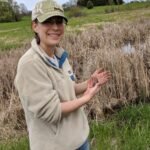 By Sarah A. Orlofske, PhD, Assistant Professor & Curator of Animal Parasites, University of Wisconsin – Stevens Point
By Sarah A. Orlofske, PhD, Assistant Professor & Curator of Animal Parasites, University of Wisconsin – Stevens Point
This article originally appeared in Wisconsin Waterfowl Association’s June, 2020 Newsletter edition.
The first waterfowl band I encountered was actually not a real band at all. It was a goose sized band, but distributed from the Wisconsin Conservation Wardens at the Sports Show in Milwaukee when I was a child. It had imprinted on it the contact info to report wildlife violations. However, most waterfowl bands serve a very different purpose.
 Banding allows wildlife researchers to use mark-recapture techniques to predict the impacts of harvest and examine environmental variables that influence migratory bird populations. But the impact of banding extends even beyond waterfowl populations. Because birds can be potential biological indicators, understanding waterfowl populations can help researchers investigate environmental health and provide and early warning of ecological issues. One of the most important contributions you can make as a waterfowl hunter is to report your banded birds. It is important to remember that more data equal better models, which makes implementing management strategies more effective.
Banding allows wildlife researchers to use mark-recapture techniques to predict the impacts of harvest and examine environmental variables that influence migratory bird populations. But the impact of banding extends even beyond waterfowl populations. Because birds can be potential biological indicators, understanding waterfowl populations can help researchers investigate environmental health and provide and early warning of ecological issues. One of the most important contributions you can make as a waterfowl hunter is to report your banded birds. It is important to remember that more data equal better models, which makes implementing management strategies more effective.
 The second way you can contribute to banding data is as a volunteer for banding events. In my new role as the Waterfowl Banding Coordinator for WWA, my goal is to help WWA members get involved and engaged in state-wide banding opportunities to help learn more about waterfowl and help the scientists and resource managers study the populations and distributions of waterfowl. Ducks and geese are typically banded using volunteers to help biologists process large numbers of birds safely and effectively by reducing stress to the animals. Geese are usually captured when they are molting their primary flight feathers and cannot fly. Volunteers and biologists herd them into pens. Ducks are captured later in summer with the use of baited traps. Volunteers are involved in several tasks to assist biologists with handling birds, collecting data, and releasing birds after banding is complete. I hope to assist with communication from groups and individuals to connect volunteers with opportunities and compile records of WWA member contributions to banding efforts.
The second way you can contribute to banding data is as a volunteer for banding events. In my new role as the Waterfowl Banding Coordinator for WWA, my goal is to help WWA members get involved and engaged in state-wide banding opportunities to help learn more about waterfowl and help the scientists and resource managers study the populations and distributions of waterfowl. Ducks and geese are typically banded using volunteers to help biologists process large numbers of birds safely and effectively by reducing stress to the animals. Geese are usually captured when they are molting their primary flight feathers and cannot fly. Volunteers and biologists herd them into pens. Ducks are captured later in summer with the use of baited traps. Volunteers are involved in several tasks to assist biologists with handling birds, collecting data, and releasing birds after banding is complete. I hope to assist with communication from groups and individuals to connect volunteers with opportunities and compile records of WWA member contributions to banding efforts.
 The biggest question is what type of banding activities will be available this year due to COVID-19 closures, restrictions on group sizes and requirements for social distancing. The response to COVID-19 was already responsible for the cancellation of spring waterfowl surveys. The National Bird Banding Laboratory has some COVID-19 updates posted on their website, but we are still waiting for more information at the state level. In the ever-changing situation, we will hopefully have updates soon on banding activities and I will do my best to pass along that information. If you are interested in banding activities and getting more involved please feel free to contact me at sorlofsk@uwsp.edu.
The biggest question is what type of banding activities will be available this year due to COVID-19 closures, restrictions on group sizes and requirements for social distancing. The response to COVID-19 was already responsible for the cancellation of spring waterfowl surveys. The National Bird Banding Laboratory has some COVID-19 updates posted on their website, but we are still waiting for more information at the state level. In the ever-changing situation, we will hopefully have updates soon on banding activities and I will do my best to pass along that information. If you are interested in banding activities and getting more involved please feel free to contact me at sorlofsk@uwsp.edu.
Check out the following websites for more information about waterfowl banding activities.
